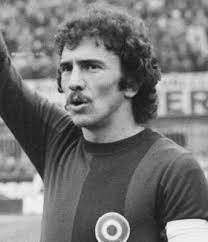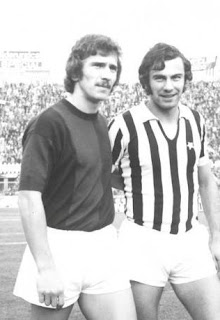NEW - Giuseppe Savoldi - footballer
The world’s first £1 million player
Giuseppe Savoldi, whose transfer from Bologna to Napoli in 1975 made him the first footballer in the world to be bought for £1 million, was born on this day in 1947 in Gorlago, a municipality a short distance from the city of Bergamo in Lombardy. A prolific striker, Savoldi’s big-money deal came four years ahead of the much heralded £1 million transfer of another striker, Trevor Francis, from Birmingham City to Nottingham Forest, which made him the first player in Britain to move for a seven-figure sum. Napoli, who saw Savoldi as the last component in what they hoped would be a title-winning team, paid 1.4 billion lire in cash, plus two players, Sergio Clerici and Romario Rampanti, to secure his signature. The two players were valued at 600 million lire in total, which valued Savoldi at 2 billion lire, the equivalent at the time of about £1.2 million. But where Francis, who later spent five seasons playing in Serie A, won two European Cups with Nottingham Forest, scoring the winning goal in the final in 1979, Savoldi’s move did not yield anything like the same kind of success. Napoli had finished third and then second in Serie A in the seasons before Savoldi’s arrival but were unable to maintain their momentum. Read more…
_________________________________________________________
Gennaro Contaldo – Chef
TV cook is passionate about Amalfi’s speciality dishes
Celebrity chef Gennaro Contaldo was born on this day in 1949 in Minori in Campania. Contaldo has made many appearances on British television alongside chefs such as the late Antonio Carluccio, Jamie Oliver and James Martin and he has also brought out several cook books. It is well documented that he is the man responsible for inspiring Jamie Oliver’s interest in Italian food. Contaldo grew up in the small seaside town of Minori near Amalfi and is a passionate advocate of the style of cooking in the area, cucina amalfitana. From an early age he was interested in dishes cooked with local produce, going out to collect wild herbs for his mother, and he began helping out in local restaurants at the age of eight. Contaldo moved to Britain in the late 1960s and travelled around the country working in village restaurants and studying the food growing wild in each area, such as herbs and mushrooms. He eventually went to London and worked in several restaurants, including Antonio Carluccio’s establishment in Neal Street. Read more…
_________________________________________________________
Pietro Rava - World Cup winner
Defender was the last survivor from Azzurri of 1938
Pietro Rava, who was the last survivor of Italy's 1938 World Cup-winning football team when he died in December 2006, was born on this day in 1916 at Cassine in Piedmont. A powerful defender who could play at full back or in a central position, Rava won 30 caps for the national team between 1935 and 1946, finishing on the losing side only once and being made captain in 1940. He was also a member of the Italy team that won the gold medal in the football competition at the 1936 Olympics in Berlin. At club level, he spent most of his career with Juventus, forming a formidable defensive partnership with Alfredo Foni, alongside whom he also lined up in the national side. Rava won a Championship medal in 1949-50, his final season at Juventus, although by then he had fallen out of favour with Jesse Carver, the Turin club's English coach, and made only six appearances, moving to Novara the following year. At the time of his birth, Rava's family were living in Cassine, a small town near Alessandria, about 100km (62 miles) south-east of Turin, because of his father's job with a railway company. Read more…
_________________________________________________________
Antonio Janigro - conductor and cellist
Musician who found ‘accidental’ fame in Yugoslavia
The conductor and cellist Antonio Janigro, who spent more than two decades as an orchestra leader in Zagreb, Yugoslavia, was born on this day in 1918 in Milan. An accomplished cello soloist in Italy, his adventure in Yugoslavia happened by accident, in a way. He was on holiday there in 1939 when the Second World War began, leaving him stranded with no prospect of returning home. Happily, Zagreb Conservatory offered Janigro a job as professor of cello and chamber music. This turned out to be a providential turn of fate and he was to remain in Yugoslavia for much of his life. He founded the school of modern cello playing in Yugoslavia, formed the exemplary chamber orchestra I Solisti di Zagreb with Dragutin Hrdjok in 1954 and for 10 years led the Radio Zagreb symphony orchestra. Raised in a house on the Via Guido d’Arezzo in Milan, Janigro was born in a musical family, although his father’s dream of becoming a concert pianist had to be abandoned, sadly, when he lost his arm after being shot in the First World War. Janigro himself studied piano from the age of six, and then began playing the cello in 1926, when he was eight years old. Read more…
__________________________________________________________
Camillo Golgi – neuroscientist
Nobel prize winner whose name lives on in medical science
Camillo Golgi, who is recognised as the greatest neuroscientist and biologist of his time, died on this day in 1926 in Pavia. He was well known for his research into the central nervous system and discovering a staining technique for studying tissue, sometimes called Golgi’s method, or Golgi’s staining. In 1906, Golgi and a Spanish biologist, Santiago Ramon y Cajal, were jointly awarded the Nobel Prize in Physiology or Medicine in recognition of their work on the structure of the nervous system. Golgi was born in 1843 in Corteno, a village in the province of Brescia in Lombardy. The village was later renamed Corteno Golgi in his honour. In 1860 Golgi went to the University of Pavia to study medicine. After graduating in 1865 he worked in a hospital for the Italian army and as part of a team investigating a cholera epidemic in the area around Pavia. He resumed his academic studies under the supervision of Cesare Lombroso, an expert in medical psychology, and wrote a thesis about mental disorders. As he became more and more interested in experimental medicine he started attending the Institute of General Pathology headed by Giulio Bizzozero, who was to influence Golgi’s research publications. Read more…




















